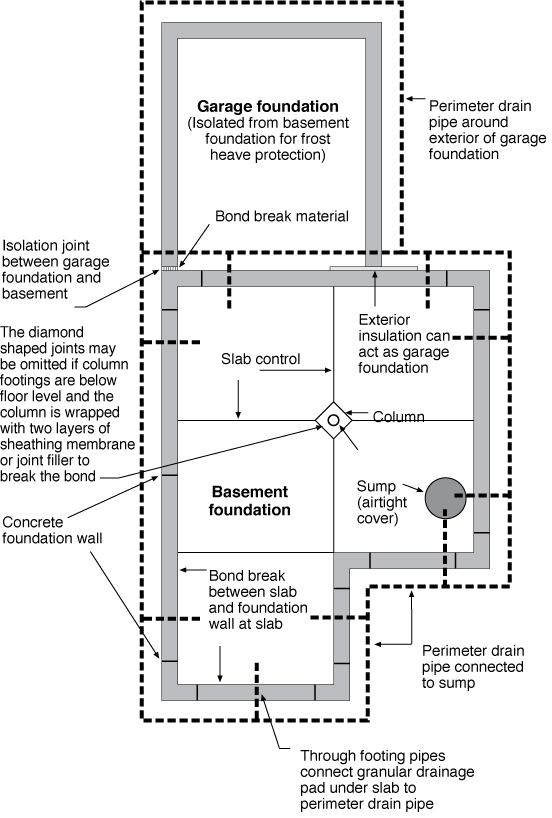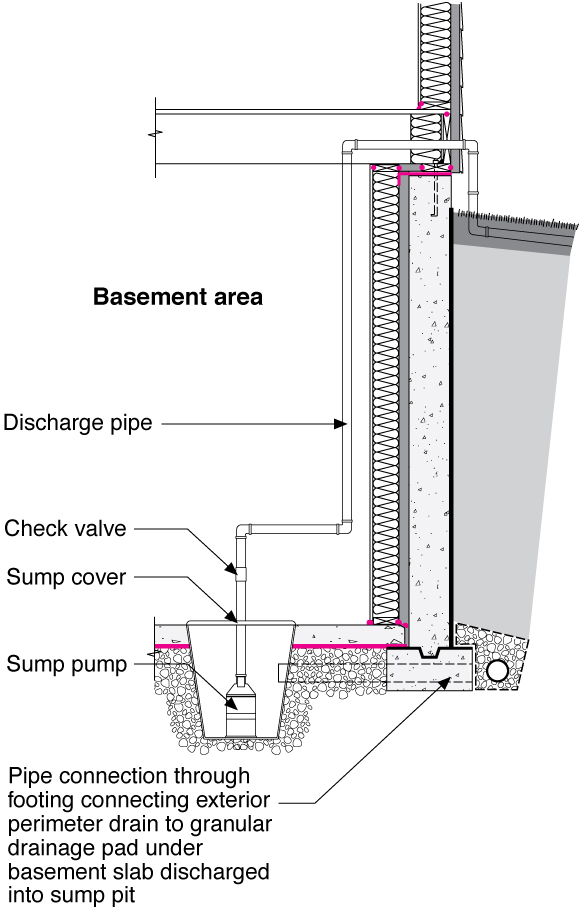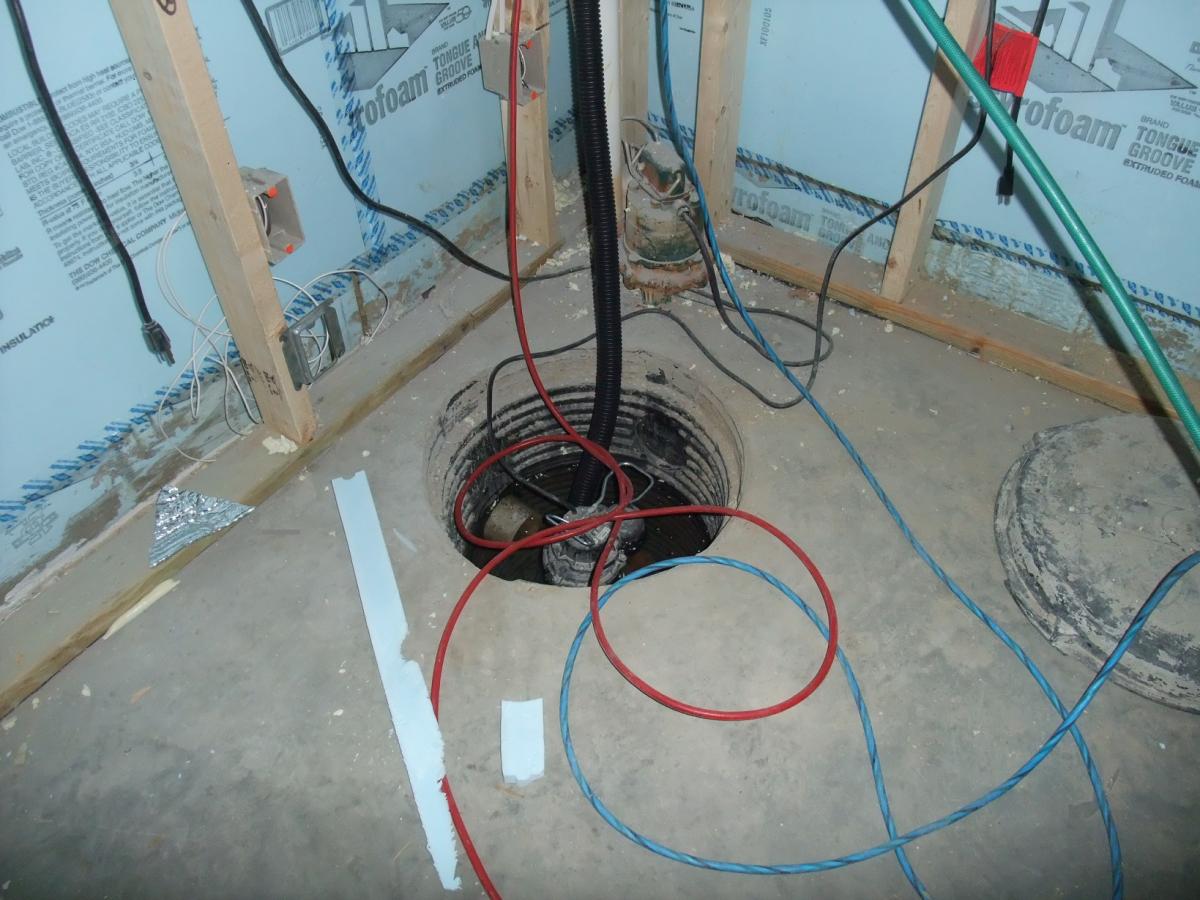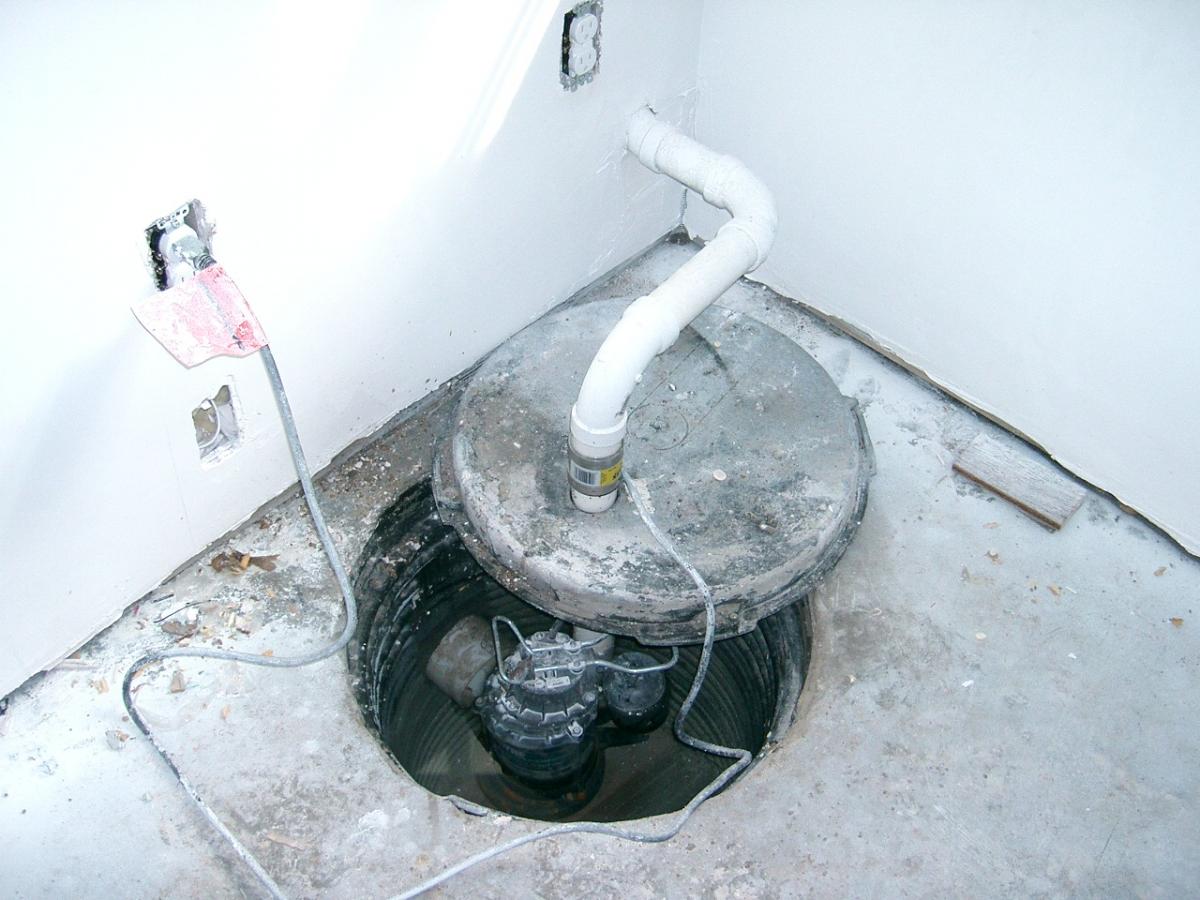How to Install a Sump Pit in Basement
Drain or Sump Pump Installed in Basements or Crawlspaces
Scope
Install a drain or sump pump in homes with a basement or crawlspace. General instructions for installing a sump pump are as follows. For additional details see the Description tab.
- Select a location in the basement or crawlspace.
- Dig a hole or remove the concrete floor.
- Place gravel in the bottom of the sump pit and place the liner.
- Install the sump pump, wiring, and the discharge pipe with the check valve.
- Cover with a gasketed, airtight cover.
See the Compliance Tab for related codes and standards requirements, and criteria to meet national programs such as DOE's Zero Energy Ready Home program, ENERGY STAR Certified Homes, and Indoor airPLUS.
Description
Bulk water must be drained from the lowest portions of the foundation (below the interior finish floor level): this is the function of the footing drain, which is in turn drained to daylight or to a sump pit and pumped out (see Figure 1). The drain or sump (Figure 2) keeps ground water levels below interior floor levels and also drains away any water that has been collected by the foundation wall drainage system.
The outflow from the sump pit must be directed to a storm sewer (if permitted by your local municipality) or a dry well away from the foundation. Depositing the outflow next to the foundation will result in simply "recycling" water in and out through the foundation drainage system. The sump pit should have an airtight cover for indoor air quality reasons; if not covered, the sump can allow soil gases (including radon, water vapor, herbicides, termiticides, methane, etc.) into the home, which can be detrimental to occupant health. See the guide Sump Pump Cover Gasket for more information about covering the sump pit.


How to Install a Sump Pump
- Select a location in the basement or the crawlspace. The sump pump should be located in the lowest spot of the floor, near a wall so the discharge pipe can be easily directed outside and near an electrical outlet to power the sump pump. Select a sump pump with a tight fitting, gasketed cover that is mechanically fastened. Sump covers that permit observation of conditions in the sump pit are recommended.
- For a retrofit case, dig a hole or remove the concrete floor 6 to 10 inches deeper and wider than the sump liner. For new construction, the hole should be approximately the same size as the sump liner (see Figure 3).
- Fill the bottom of the sump pit with gravel and place the liner. Connect the sump pit to the perimeter drain or the sub-slab gravel field by using a perforated sump pit liner or through-footing pipes that are connected to the perimeter drain. In a retrofit case, fill the sump pit with additional gravel around the sump liner and place a layer of concrete at the edge of the liner.
Figure 3. Install the sump pit liner. (Source: Building Science Corporation.) - Install the discharge pipe to direct water out and away from the building. Install a check valve to prevent discharged water from flowing back into the sump pit when the sump pump turns off. Place the pump in the sump pit and plug it in (Figure 4). Make sure the float is unobstructed. The outlet may need to be a GFCI (ground fault circuit interrupter) safety outlet - refer to the List of NFPA Codes & Standards.
Figure 4. Install the sump pump. (Source: Building Science Corporation.) - Place the airtight cover on the sump and connect the last section of the discharge pipe (Figure 5). See the guide Gasketed/Sealed Sump Covers for more information.
Figure 5. Install the sump pump cover. (Source: Building Science Corporation.) - If the sump is installed in a concrete slab, caulk around the outside edge of the sump pit liner where the liner meets the concrete (EPA 1994). If the sump is installed in a crawlspace with a dirt floor covered by a polyethylene vapor barrier, ensure that polyethylene covers the ground around the sump pump and is taped to the rim of the liner.
Ensuring Success
Test the sump pump system to ensure that water is properly discharged out and away from the building. Verify the cover is tightly placed over the sump pit to prevent soil gases from entering the building.
Climate
No climate specific information applies.
Right and Wrong Images
This sump pump is installed correctly
Wrong – The sump pump does not have a cover
Right – The sump pump has a sealed cover that is mechanically attached
Wrong – The sump pump does not have a cover
Right – The sump pump has a sealed cover that is mechanically attached
Wrong - The sump pump alone cannot address the water infiltration issues in this crawlspace.
Wrong - The sump pump pit should be covered with a gasketed lid.
The Compliance tab contains both program and code information. Code language is excerpted and summarized below. For exact code language, refer to the applicable code, which may require purchase from the publisher. While we continually update our database, links may have changed since posting. Please contact our webmaster if you find broken links.
ENERGY STAR Certified Homes, Version 3/3.1 (Rev. 09)
Water Management System Builder Requirements
1. Water-Managed Site and Foundation.
1.7 Sump pump covers mechanically attached with full gasket seal or equivalent.
See the guide Sump Pump Cover Gasket for more information about meeting this ENERGY STAR requirement.
Please see the ENERGY STAR Certified Homes Implementation Timeline for the program version and revision currently applicable in in your state.
DOE Zero Energy Ready Home (Revision 07)
Exhibit 1 Mandatory Requirements.
Exhibit 1, Item 1) Certified under the ENERGY STAR Qualified Homes Program or the ENERGY STAR Multifamily New Construction Program.
Exhibit 1, Item 6) Certified under EPA Indoor airPLUS.
EPA Indoor airPLUS (Revision 04)
1.1 Site and Foundation Drainage. Install a drain or sump pump in basement and crawlspace floors, discharging to daylight at least 10 ft. outside the foundation or into an approved sewer system. Section 1.1 allows exceptions for slab-on-grade foundations and for areas with free-draining soils that are identified as Group 1 (Table R405.1, 2015 IRC) by a certified hydrologist, soil scientist, or engineer through a site visit.
2009, 2012, 2015, and2018 International Residential Code
Chapter 30 Sanitary Drainage, Section P3007 Sumps and Ejectors
Chapter 33 Storm Drainage, Section P3303 Sumps and Pumping Systems
Retrofit: 2009, 2012, 2015, 2018, and 2021 IRC
Section R102.7.1 Additions, alterations, or repairs. Additions, alterations, renovations, or repairs shall conform to the provisions of this code, without requiring the unaltered portions of the existing building to comply with the requirements of this code, unless otherwise stated. (See code for additional requirements and exceptions.)
Appendix J regulates the repair, renovation, alteration, and reconstruction of existing buildings and is intended to encourage their continued safe use.
This Retrofit tab provides information that helps installers apply this "new home" guide to improvement projects for existing homes. This tab is organized with headings that mirror the new home tabs, such as "Scope," "Description," "Success," etc. If there is no retrofit-specific information for a section, that heading is not included.
Access to some references may require purchase from the publisher. While we continually update our database, links may have changed since posting. Please contact our webmaster if you find broken links.
References and Resources*
*For non-dated media, such as websites, the date listed is the date accessed.
Contributors to this Guide
The following authors and organizations contributed to the content in this Guide.
Mobile Field Kit
The Building America Field Kit allows you to save items to your profile for review or use on-site.
Sign Up or Log In
Did you find this information helpful?
How to Install a Sump Pit in Basement
Source: https://basc.pnnl.gov/resource-guides/drain-or-sump-pump-installed-basements-or-crawlspaces

